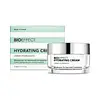What's inside
What's inside
 Key Ingredients
Key Ingredients

 Benefits
Benefits

 Concerns
Concerns

 Ingredients Side-by-side
Ingredients Side-by-side

Water
Skin ConditioningPrunus Amygdalus Dulcis Oil
Skin ConditioningGlycerin
HumectantCetearyl Alcohol
EmollientCetearyl Olivate
Sorbitan Olivate
EmulsifyingAlthaea Officinalis Root Extract
Skin ConditioningChamomilla Recutita Flower Extract
MaskingPhragmites Karka Extract
Skin ConditioningPoria Cocos Extract
Skin ConditioningOlea Europaea Fruit Oil
MaskingOenothera Biennis Oil
EmollientGlycine Soja Oil
EmollientCalendula Officinalis Flower Extract
MaskingTocopherol
AntioxidantAristotelia Chilensis Seed Oil
EmollientRosmarinus Officinalis Leaf Extract
AntimicrobialSodium Hyaluronate
HumectantCamellia Sinensis Leaf Extract
AntimicrobialHelianthus Annuus Seed Oil
EmollientXanthan Gum
EmulsifyingSodium Benzoate
MaskingCitric Acid
BufferingSodium Citrate
BufferingBenzyl Alcohol
PerfumingDehydroacetic Acid
PreservativeWater, Prunus Amygdalus Dulcis Oil, Glycerin, Cetearyl Alcohol, Cetearyl Olivate, Sorbitan Olivate, Althaea Officinalis Root Extract, Chamomilla Recutita Flower Extract, Phragmites Karka Extract, Poria Cocos Extract, Olea Europaea Fruit Oil, Oenothera Biennis Oil, Glycine Soja Oil, Calendula Officinalis Flower Extract, Tocopherol, Aristotelia Chilensis Seed Oil, Rosmarinus Officinalis Leaf Extract, Sodium Hyaluronate, Camellia Sinensis Leaf Extract, Helianthus Annuus Seed Oil, Xanthan Gum, Sodium Benzoate, Citric Acid, Sodium Citrate, Benzyl Alcohol, Dehydroacetic Acid
Water
Skin ConditioningCaprylic/Capric Triglyceride
MaskingButylene Glycol
HumectantC12-20 Acid PEG-8 Ester
EmulsifyingCetyl Alcohol
EmollientTocopherol
AntioxidantPhenoxyethanol
PreservativeSodium Hyaluronate
HumectantEthylhexylglycerin
Skin ConditioningCarbomer
Emulsion StabilisingSorbitan Oleate
EmulsifyingPotassium Sorbate
PreservativePotassium Hydroxide
BufferingCitric Acid
BufferingHordeum Vulgare Seed Extract
Skin ConditioningSh-Oligopeptide-1
Skin Conditioning
 Reviews
Reviews

Ingredients Explained
These ingredients are found in both products.
Ingredients higher up in an ingredient list are typically present in a larger amount.
Citric Acid is an alpha hydroxy acid (AHA) naturally found in citrus fruits like oranges, lemons, and limes.
Like other AHAs, citric acid can exfoliate skin by breaking down the bonds that hold dead skin cells together. This helps reveal smoother and brighter skin underneath.
However, this exfoliating effect only happens at high concentrations (20%) which can be hard to find in cosmetic products.
Due to this, citric acid is usually included in small amounts as a pH adjuster. This helps keep products slightly more acidic and compatible with skin's natural pH.
In skincare formulas, citric acid can:
While it can provide some skin benefits, research shows lactic acid and glycolic acid are generally more effective and less irritating exfoliants.
Most citric acid used in skincare today is made by fermenting sugars (usually from molasses). This synthetic version is identical to the natural citrus form but easier to stabilize and use in formulations.
Read more about some other popular AHA's here:
Learn more about Citric AcidSodium Hyaluronate is hyaluronic acid's salt form. It is commonly derived from the sodium salt of hyaluronic acid.
Like hyaluronic acid, it is great at holding water and acts as a humectant. This makes it a great skin hydrating ingredient.
Sodium Hyaluronate is naturally occurring in our bodies and is mostly found in eye fluid and joints.
These are some other common types of Hyaluronic Acid:
Learn more about Sodium HyaluronateTocopherol (also known as Vitamin E) is a common antioxidant used to help protect the skin from free-radicals and strengthen the skin barrier. It's also fat soluble - this means our skin is great at absorbing it.
Vitamin E also helps keep your natural skin lipids healthy. Your lipid skin barrier naturally consists of lipids, ceramides, and fatty acids. Vitamin E offers extra protection for your skin’s lipid barrier, keeping your skin healthy and nourished.
Another benefit is a bit of UV protection. Vitamin E helps reduce the damage caused by UVB rays. (It should not replace your sunscreen). Combining it with Vitamin C can decrease sunburned cells and hyperpigmentation after UV exposure.
You might have noticed Vitamin E + C often paired together. This is because it is great at stabilizing Vitamin C. Using the two together helps increase the effectiveness of both ingredients.
There are often claims that Vitamin E can reduce/prevent scarring, but these claims haven't been confirmed by scientific research.
Learn more about TocopherolWater. It's the most common cosmetic ingredient of all. You'll usually see it at the top of ingredient lists, meaning that it makes up the largest part of the product.
So why is it so popular? Water most often acts as a solvent - this means that it helps dissolve other ingredients into the formulation.
You'll also recognize water as that liquid we all need to stay alive. If you see this, drink a glass of water. Stay hydrated!
Learn more about Water